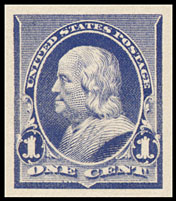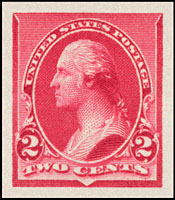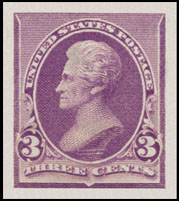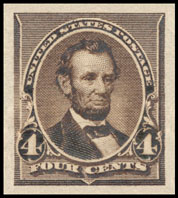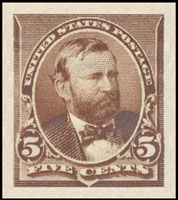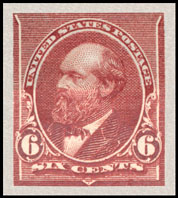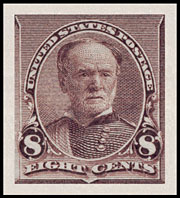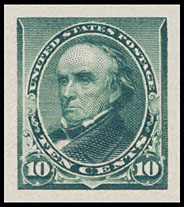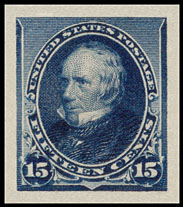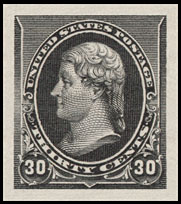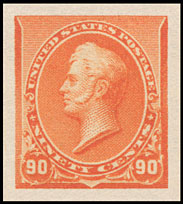
Designs of the Issues of 1890
'Baby Bank Notes' of the American Bank Note Company
American Bank Note Company - Perf. 12
Unwatermarked Soft Porous Paper
Uniform Design Size: 19 x 22 mm
Note the lack of triangles at upper left and right
More information
1894 First Bureau Issue "Triangles"
Click on underlined Catalog Numbers below to see more details.
1¢ Franklin
of 1890
Designer: Thomas F. Morris Vignette: Edward C. Steimle
Frame: Douglas S. Ronaldson Lettering: D. S. Ronaldson
| Year | Number | EDU | No. Issued* | Printer | Design Size | Colors/Varieties | Straight-edge Possible | Purpose |
| 1890 | 219 | 2/27/1890 | 2,206,093,450 | American | 19 x 22 mm Note that this issue is often called the "Baby Bank Note" issue due to the smaller size of these Bank Notes. |
dull blue, deep blue, ultramarine; double transfer; Plate Nos.: C 11-15; G 36-40; Q 89-93; BB 145-149; FF 165-169; UU 240-244 ; C1 280-284; D1 285-289; F1 295-299 |
sheets of 400 stamps cut into four panes of 100 all four sides are candidates for a natural straight-edge |
the one-cent stamp paid the rate for domestic third class mail and for drop letters |
2¢ Washington
of 1890
Designer: Thomas F. Morris Vignette: Charles Skinner
Frame: Douglas S. Ronaldson Lettering: D. S. Ronaldson
| Year | Number | EDU | No. Issued* | Printer | Design Size | Colors/Varieties | Straight-edge Possible | Purpose |
| 1890 | 219D | 2/22/1890 First Day |
~100 million | American | 19 x 22 mm | lake; double transfer; at least 21 Pl #'s known | sheets of 200 or
400 stamps cut into panes of 100 all four sides are candidates for a natural straight-edge |
the two-cent stamp paid the rate for domestic first class mail |
| 1890 | 220 | 3/11/1890 | 6,144,819,500 | American | 19 x 22 mm | carmine; dark carmine; rose; carmine rose; about 255 Pl #'s known |
||
| 1892? | 220a cap over left "2" EDU 9/9/1892 | --- | American | 19 x 22 mm | carmine/cap on left
"2"; Plate #'s 235-236; 246-248 |
|||
| 1892? | 220c cap over both 2's EDU 7/7/1892 | --- | American | 19 x 22 mm | carmine/cap on both "2"s; setenant pair 220a & 220c Plate #'s 245-246 |
|||
3¢ Jackson
of 1890
Designer: Thomas F. Morris Vignette: Charles Skinner
Frame: Douglas S. Ronaldson Lettering: D. S. Ronaldson
| Year | Number | EDU | No. Issued | Printer | Design Size | Color/Varieties | Straight-edge Possible | Purpose |
| 1890 | 221 | 2/28/1890 | 46,877,200 | American | 19 x 22 mm | purple; bright purple; dark purple; Plate Nos. 21, 72 |
sheets of 200 cut vertically into panes of 100 only the left and right sides are candidates for a natural straight-edge |
the three-cent stamp was used to complete other rates |
4¢ Lincoln
of 1890
Designer: Thomas F. Morris Vignette: Alfred Jones
Frame: Douglas S. Ronaldson Lettering: D. S. Ronaldson
| Year | Number | EDU | No. Issued | Printer | Design Size | Color/Varieties | Straight-edge Possible | Purpose |
| 1890 | 222 | 7/16/1890 | 66,759,475 | American | 19 x 22 mm | dark brown, blackish brown; double transfer Plate Nos. J 51-55 MM 200-204 |
sheets of 200 cut vertically
into panes of 100 only the left and right sides are candidates for a natural straight-edge |
the four-cent stamp paid double the domestic rate for first class mail |
5¢ Grant
of 1890
Designer: Thomas F. Morris Vignette: Charles Skinner
Frame: Douglas S. Ronaldson Lettering: D. S. Ronaldson
| Year | Number | EDU | No. Issued | Printer | Design Size | Color/Varieties | Straight-edge Possible | Purpose |
| 1890 | 223 | 6/14/1890 | 152,236,530 | American | 19 x 22 mm | chocolate, yellow brown; double transfer Plate Nos. I 46-50 |
sheets of 200 cut vertically
into panes of 100 only the left and right sides are candidates for a natural straight-edge |
the five-cent stamp paid the foreign rate to most UPU destinations |
6¢ Garfield
of 1890
Designer: Thomas F. Morris Vignette: Charles Skinner
Frame: Douglas S. Ronaldson Lettering: D. S. Ronaldson
| Year | Number | EDU | No. Issued | Printer | Design Size | Color/Varieties | Straight-edge Possible | Purpose |
| 1890 | 224 | 5/8/1890 | 9,253,400 | American | 19 x 22 mm | brown red, dark brown red; Plate No. 23 |
sheets of 200 cut vertically
into panes of 100 only the left and right sides are candidates for a natural straight-edge |
the six-cent stamp was a
versatile make-up stamp for a variety of rates, domestic rates in particular |
8¢ Sherman
of 1890
Designer: Thomas F. Morris Vignette: Charles Skinner
Frame: Douglas S. Ronaldson Lettering: D. S. Ronaldson
| Year | Number | EDU | No. Issued | Printer | Design Size | Color/Varieties | Straight-edge Possible | Purpose |
| 1893 | 225 | 5/4/1893 | 12,087,800 | American | 19 x 22 mm | lilac, grayish lilac, magenta; Plate #'s ZZ 265-269 |
sheets of 200 cut vertically
into panes of 100 only the left and right sides are candidates for a natural straight-edge |
the eight-cent stamp paid the registry rate starting Jan. 1, 1893 |
10¢ Webster
of 1890
Designer: Thomas F. Morris Vignette: Charles Skinner
Frame: Douglas S. Ronaldson Lettering: D. S. Ronaldson
| Year | Number | EDU | No. Issued | Printer | Design Size | Color/Varieties | Straight-edge Possible | Purpose |
| 1890 | 226 | 3/5/1890 | 72,746,160 | American | 19 x 22 mm | green, bluish green, dark green; double transfer; Plate Nos. E 26-30 |
sheets of 200 cut vertically
into panes of 100 only the left and right sides are candidates for a natural straight-edge |
the ten-cent stamp paid the registry rate until Jan.1, 1893; it also paid double the UPU rate |
15¢ Clay
of 1890
Designer: Thomas F. Morris Vignette: Charles Skinner
Frame: Douglas S. Ronaldson Lettering: D. S. Ronaldson
| Year | Number | EDU | No. Issued | Printer | Design Size | Color/Varieties | Straight-edge Possible | Purpose |
| 1890 | 227 | 5/16/1890 | 5,548,710 | American | 19 x 22 mm | indigo, deep indigo; double
transfer; triple transfer Plate No. 22 |
sheets of 200 cut vertically
into panes of 100 only the left and right sides are candidates for a natural straight-edge |
the fifteen-cent stamp was a versatile make-up stamp for a variety of rates; registered letters and foreign rates in particular |
30¢ Jefferson
of 1890
Designer: Thomas F. Morris Vignette: Alfred Jones
Frame: Douglas S. Ronaldson Lettering: D. S. Ronaldson
| Year | Number | EDU | No. Issued | Printer | Design Size | Color/Varieties | Straight-edge Possible | Purpose |
| 1890 | 228 | 4/14/1890 | 1,504,408 | American | 19 x 22 mm | black, full black, gray black; Plate No. 24 |
sheets of 200 cut vertically
into panes of 100 only the left and right sides are candidates for a natural straight-edge |
the thirty-cent stamp was a versatile make-up stamp for a variety of rates; small parcels and foreign rates in particular |
90¢ Perry
of 1890
Designer: Thomas F. Morris Vignette: Edward G. Steimle
Frame: Douglas S. Ronaldson Lettering: D. S. Ronaldson
| Year | Number | EDU | No. Issued | Printer | Design Size | Color/Varieties | Straight-edge Possible | Purpose |
| 1890 | 229 | ?/16/1890 month unknown, off-cover example next earliest is 2/7/1892 (on cover) |
219,721 | American | 19 x 22 mm | orange, yellow orange, red orange; short transfer at bottom Plate No. 25 |
sheets of 200 cut vertically
into panes of 100 only the left and right sides are candidates for a natural straight-edge |
the ninety-cent stamp was a versatile make-up stamp for a variety of rates; parcels for both domestic and foreign destinations, in particular fewer than 100 covers are known |
Notes:
The EDU information is based on the best information available.
The straight-edge information is provided to assist in determining whether a stamp is a candidate for a reperfed straight-edge. Note that the 3¢ through 90¢ stamps were not made with naturally occurring straight-edges at top or bottom. Thus, it is unlikely that the perfs at the top or bottom of these stamps would be reperfed. On the other hand, well centered stamps should be closely examined at left and right to insure the perfs are genuine.
Bibliography and suggested additional reading:
The Postage Stamps of the 19th Century, Volume III, by Lester Brookman (1967)
The 1949 Scott U.S. Specialized Stamp Catalogue Scott Stamp & Coin Co. Limited
Design dimensions:
The Postage Stamps of the United States, John Luff (1902 and 1937)
Colors:
The Encyclopedia of the Colors of United States Postage Stamps - Volume 2 Issues of 1869-1893, by Roy H. White (1981)
The Micarelli Identification Guide to U.S. Stamps: Regular Issues 1847-1934 by Charles N. Micarelli
Additional Resources
Year In Stamps - 1890 Collectors Club USPCS Chronicle Siegel Auction GalleriesBrookman PDF download
